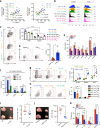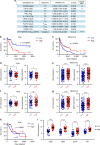Specialized dendritic cells induce tumor-promoting IL-10+IL-17+ FoxP3neg regulatory CD4+ T cells in pancreatic carcinoma
- PMID: 30926808
- PMCID: PMC6441038
- DOI: 10.1038/s41467-019-09416-2
Specialized dendritic cells induce tumor-promoting IL-10+IL-17+ FoxP3neg regulatory CD4+ T cells in pancreatic carcinoma
Abstract
The drivers and the specification of CD4+ T cell differentiation in the tumor microenvironment and their contributions to tumor immunity or tolerance are incompletely understood. Using models of pancreatic ductal adenocarcinoma (PDA), we show that a distinct subset of tumor-infiltrating dendritic cells (DC) promotes PDA growth by directing a unique TH-program. Specifically, CD11b+CD103- DC predominate in PDA, express high IL-23 and TGF-β, and induce FoxP3neg tumor-promoting IL-10+IL-17+IFNγ+ regulatory CD4+ T cells. The balance between this distinctive TH program and canonical FoxP3+ TREGS is unaffected by pattern recognition receptor ligation and is modulated by DC expression of retinoic acid. This TH-signature is mimicked in human PDA where it is associated with immune-tolerance and diminished patient survival. Our data suggest that CD11b+CD103- DC promote CD4+ T cell tolerance in PDA which may underscore its resistance to immunotherapy.
Conflict of interest statement
G.M. has research agreements with GSK, Pfizer, and Puretech Health. The remaining authors declare no competing interests.
Figures






References
Publication types
MeSH terms
Substances
Grants and funding
LinkOut - more resources
Full Text Sources
Medical
Molecular Biology Databases
Research Materials

